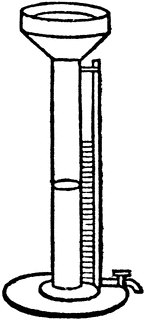
When the wheel turns the pen arm moves either up or down leaving a trace on the graph and at the same time making a loud click. The recorder consists of a pen mounted on an arm attached to a geared wheel that moves once with each signal sent from the collector. After an amount of precipitation equal to 0.2 mm (0.007 in) falls, the lever tips and an electrical signal is sent to the recorder. The precipitation falls onto one of two small buckets or levers which are balanced in same manner as a scale. At the top of the cylinder is a funnel that collects and channels the precipitation.

The tipping bucket rain gauge consists of a large copper cylinder set into the ground. This is extremely helpful for scientists studying the effects of greenhouse gases released into the atmosphere and their effects on the levels of the acid rain. The weighing-type recording gauge may also contain a device to measure the quantity of chemicals contained in the location's atmosphere. These gauges are, however, more expensive and require more maintenance than tipping bucket gauges. The advantages of this type of gauge over tipping buckets are that it does not underestimate intense rain, and it can measure other forms of precipitation, including rain, hail and snow. Certain models measure the mass using a pen on a rotating drum, or by using a vibrating wire attached to a data logger. This pipe then fits over a metal rod that has been placed in the ground.Ī weighing-type precipitation gauge consists of a storage bin, which is weighed to record the mass. A metal pipe is attached to the container and can be adjusted to ensure the rain gauge is level. The larger container collects any rainfall amounts over 25 mm that flows from a small hole near the top of the cylinder. Each horizontal line on the cylinder is 0.2 mm (0.007 in). In most cases the cylinder is marked in mm and in the picture above will measure up to 25 mm (0.98 in) of rainfall.

When measurements are taken, the cylinder will be measured and then the excess will be put in another cylinder and measured.

If the water overflows from the graduated cylinder the outside container will catch it. The standard rain gauge, developed around the start of the 20th century, consists of a funnel attached to a graduated cylinder that fits into a larger container. Each type has its advantages and disadvantages for collecting rain data. Types of rain gauges include graduated cylinders, weighing gauges, tipping bucket gauges, and simple buried pit collectors.


 0 kommentar(er)
0 kommentar(er)
